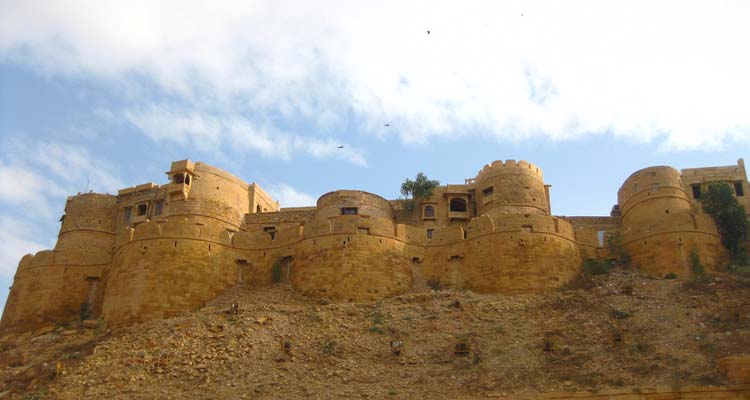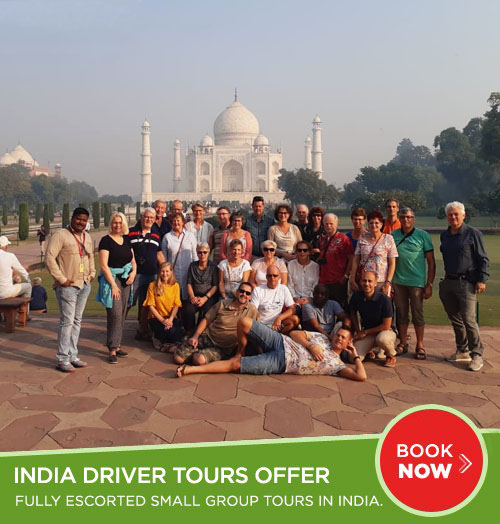Jaisalmer, the “Golden City,” is located on the westernmost frontier of India in the state of Rajasthan, located 575 kilometres (357 mi) west of the state capital Jaipur. Once known as Jaisalmer state it is a World Heritage Site. The town stands on a ridge of yellowish sandstone, and is crowned by the ancient Jaisalmer Fort. This fort contains a royal palace and several ornate Jain temples. Many of the houses and temples of both the fort, and of the town below, are built of finely sculptured sandstone. The town lies in the heart of the Thar Desert (the Great Indian Desert).
If geology interests you, then Jaisalmer is where you need to journey. The Wood Fossil Park or Aakal is located about 15 kilometres away from the city. Here, one can discover and trace geologic tragedies that occurred in the Thar Desert 180 million years ago. The city of Jaisalmer also acts as the guard to western Rajasthan (and India’s) frontier. This ‘Golden City’ is located close to the Pakistan border and in close proximity to the Thar Desert. The city’s most prominent landmark is the Jaisalmer Fort, also called Sonar Qila (Golden Fort). Unlike most other forts in India, Jaisalmer Fort is not just a tourist attraction. It houses shops, hotels and ancient havelis (homes) where generations continue to live.
Jaisalmer traces its inception to the 12th century. History tells us of Rawal Jaisal, the eldest heir of the Rawal of Deoraj, was passed over for the throne of Lodurva and a younger half-brother was crowned king. Rawal Jaisal went looking for a new location to set up his capital when he came across sage Eesul. The sage told him about Krishna’s prophecy which said that a descendant of his Yaduvanshi clan would found a new kingdom at this same spot. It was in 1156 that Rawal Jaisal constructed a mud fort, named it Jaisalmer after himself and declared it his capital.
Tourist Attractions in Jaisalmer
One of the most magnificent attractions is the Jaisalmer Fort, also known as “Sonar Qila,” due to the yellow stone with which it was built.
Jaisalmer Fort: The Jaisalmer Fort also goes by the name Sonar Quila (Golden Fort) as it rises from the desert itself and seems to become one with the golden hues of the sand. The setting sun adds its own magic and shrouds the fort with mystique. The fort is constructed in the classic style of the royals by local craftsmen. This fort is a world heritage site and forms an important plot point in one of Satyajit Ray’s famous Feluda stories and corresponding movie, Sonar Kela (The Golden Fortress).
There are numerous lookouts (at least five) within the fort that give a great view out across the city and desert.
A tour of the royal section of the fort is available from a starting point just to the right up the stairs as you enter the main square of the fort). The audio tour takes about one hour and 15 to 30 minutes. At the final few sections, there are two advertisements in it – not a must, the view is what you come for.
Ghadsisar (Lake): Gadisar Lake was constructed in the 14th century by Maharawal Gadsi Singh to meet the water needs of his arid lands. Considering its importance, many small temples and shrines were constructed around it, transforming it into a pilgrimage centre and a tourist attraction.
Jain Temple: The Jain Temples located inside the Jaisalmer Fort date back to the 12th and 15th centuries. The temples are dedicated to Rikhabdevji and Shambhavdevji, famous Jain hermits known as ‘Tirthankars’ (wise teachers who taught people how to attain nirvana). Like all other structures in Jaisalmer, the temples are carved out of yellow sandstone. They have been built in the famed Dilwara style which is known for its beautiful architecture.
Nathmal Ji ki Haveli: Two architect brothers built Nathmal Ji Ki Haveli in the 19th century. They worked on the haveli from two sides and the outcome is a beautiful blend of the symmetrical construction. Miniature style paintings and mighty tuskers carved out of yellow sandstone are used for decoration.
Bada bagh: About 6 kilometres to the north of Jaisalmer lies Bada Bagh, also called Barabagh (literally Big Garden). This garden complex houses chhatris or royal cenotaphs of the Maharajas of Jaisalmer state, including that of Jai Singh II. The location of the garden is such that it offers wonderful sunset vistas to tourists.
Renovated streets and houses: The city is currently undergoing quite extensive renovations, and particularly the small streets on the way to the Patwon-ki-Haveli have been redone with many houses now showing off exquisitely carved front sandstone walls. The houses are much more intricate and interesting from street level than they appear from the fort.
How to reach Jaisalmer.
By Air
Jaisalmer is not directly connected by air with any part of India. Jodhpur Airport, located some 300 km away from Jaisalmer, is the nearest airport to the desert land. The airport connects Rajasthan with all major Indian cities. From Jodhpur Airport, tourists can hire cabs to reach Jaisalmer.
By Road
Jaisalmer serves rest of India by well maintained network of roadways. Deluxe and ordinary buses of Rajasthan Roadways as well as many private operates connects Jaisalmer with Jodhpur, Jaipur, Bikaner, Barmer, Mount Abu, Ahemdabad etc. From the bus terminus, passengers can avail local means of transport to reach their respective hotels or attractions.
By Train
Jaisalmer is served by both broad gauge and metre gauge railway tracks. Direct trains from Delhi, Jaipur and Jodhpur can be availed to reach Jaisalmer. The luxury train ‘Palace on Wheels’ can also be availed to reach Jaisalmer. On reaching the station, visitors can avail auto rickshaws and private taxis to reach to their respective destinations at nominal fares.


